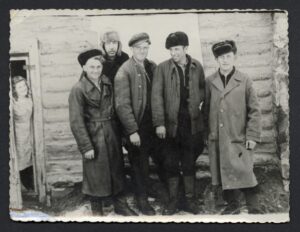
Lithuanian and Polish deportees, Marakan, Irkutsk Oblast, Soviet Union, 1954-1955, from the Sybir Memorial Museum
“Spring” – under this code name the Soviets carried out an operation of mass displacements from the territory of Lithuania that had been annexed after World War II. The action began on 22 May 1948 and lasted 48 hours. In those two days, nearly 50,000 people were displaced.
In Resolution No. 417 of the Council of Ministers of the Soviet Union, we read that the purpose of “Spring” was primarily the liquidation of the so-called forest brothers, namely Lithuanian partisans (lit. žaliukai). However, the operation coincided with Stalin’s decision a year earlier to carry out collectivization in the territories incorporated into the Soviet Union after the war. Thus, from the beginning of 1948, the Soviets created lists of people who were to be displaced. Therefore, there were not only Lithuanian partisans on these lists, but above all peasants recognized as the so-called kulaks, i.e., wealthier farmers. They were mostly Lithuanians, but also Poles and Belarusians. After their property was confiscated, they were sent with their families on freight trains to Krasnoyarsk Krai, Irkutsk Oblast and the Buryat-Mongolian Republic.
Operation “Spring” was the prelude to subsequent Soviet deportations from Latvia, Estonia and Moldova. They were all carried out by the Soviets for the same purpose: to get rid of ” dangerous anti-Soviet elements”. In such “cleansed” areas, Russification proceeded more efficiently, and the Soviets could create their “communist paradise” without any obstacles.



